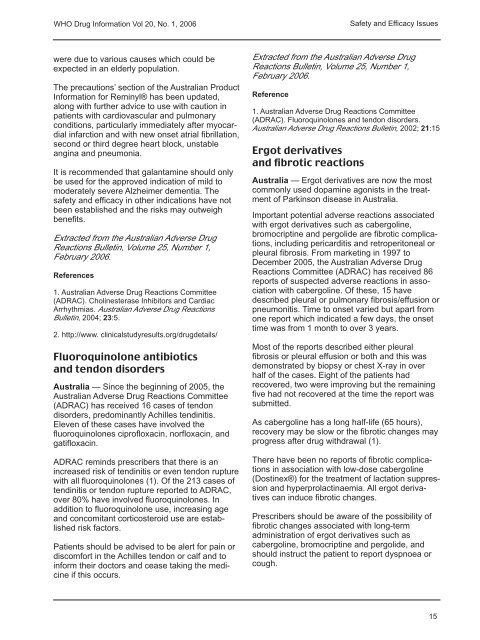WHO Drug Information Vol. 20, No. 1, 2006 - World Health ...
WHO Drug Information Vol. 20, No. 1, 2006 - World Health ...
WHO Drug Information Vol. 20, No. 1, 2006 - World Health ...
Create successful ePaper yourself
Turn your PDF publications into a flip-book with our unique Google optimized e-Paper software.
<strong>WHO</strong> <strong>Drug</strong> <strong>Information</strong> <strong>Vol</strong> <strong>20</strong>, <strong>No</strong>. 1, <strong>20</strong>06Safety and Efficacy Issueswere due to various causes which could beexpected in an elderly population.The precautions’ section of the Australian Product<strong>Information</strong> for Reminyl® has been updated,along with further advice to use with caution inpatients with cardiovascular and pulmonaryconditions, particularly immediately after myocardialinfarction and with new onset atrial fibrillation,second or third degree heart block, unstableangina and pneumonia.It is recommended that galantamine should onlybe used for the approved indication of mild tomoderately severe Alzheimer dementia. Thesafety and efficacy in other indications have notbeen established and the risks may outweighbenefits.Extracted from the Australian Adverse <strong>Drug</strong>Reactions Bulletin, <strong>Vol</strong>ume 25, Number 1,February <strong>20</strong>06.References1. Australian Adverse <strong>Drug</strong> Reactions Committee(ADRAC). Cholinesterase Inhibitors and CardiacArrhythmias. Australian Adverse <strong>Drug</strong> ReactionsBulletin, <strong>20</strong>04; 23:5.2. http://www. clinicalstudyresults.org/drugdetails/Fluoroquinolone antibioticsand tendon disordersAustralia — Since the beginning of <strong>20</strong>05, theAustralian Adverse <strong>Drug</strong> Reactions Committee(ADRAC) has received 16 cases of tendondisorders, predominantly Achilles tendinitis.Eleven of these cases have involved thefluoroquinolones ciprofloxacin, norfloxacin, andgatifloxacin.ADRAC reminds prescribers that there is anincreased risk of tendinitis or even tendon rupturewith all fluoroquinolones (1). Of the 213 cases oftendinitis or tendon rupture reported to ADRAC,over 80% have involved fluoroquinolones. Inaddition to fluoroquinolone use, increasing ageand concomitant corticosteroid use are establishedrisk factors.Patients should be advised to be alert for pain ordiscomfort in the Achilles tendon or calf and toinform their doctors and cease taking the medicineif this occurs.Extracted from the Australian Adverse <strong>Drug</strong>Reactions Bulletin, <strong>Vol</strong>ume 25, Number 1,February <strong>20</strong>06.Reference1. Australian Adverse <strong>Drug</strong> Reactions Committee(ADRAC). Fluoroquinolones and tendon disorders.Australian Adverse <strong>Drug</strong> Reactions Bulletin, <strong>20</strong>02; 21:15Ergot derivativesand fibrotic reactionsAustralia — Ergot derivatives are now the mostcommonly used dopamine agonists in the treatmentof Parkinson disease in Australia.Important potential adverse reactions associatedwith ergot derivatives such as cabergoline,bromocriptine and pergolide are fibrotic complications,including pericarditis and retroperitoneal orpleural fibrosis. From marketing in 1997 toDecember <strong>20</strong>05, the Australian Adverse <strong>Drug</strong>Reactions Committee (ADRAC) has received 86reports of suspected adverse reactions in associationwith cabergoline. Of these, 15 havedescribed pleural or pulmonary fibrosis/effusion orpneumonitis. Time to onset varied but apart fromone report which indicated a few days, the onsettime was from 1 month to over 3 years.Most of the reports described either pleuralfibrosis or pleural effusion or both and this wasdemonstrated by biopsy or chest X-ray in overhalf of the cases. Eight of the patients hadrecovered, two were improving but the remainingfive had not recovered at the time the report wassubmitted.As cabergoline has a long half-life (65 hours),recovery may be slow or the fibrotic changes mayprogress after drug withdrawal (1).There have been no reports of fibrotic complicationsin association with low-dose cabergoline(Dostinex®) for the treatment of lactation suppressionand hyperprolactinaemia. All ergot derivativescan induce fibrotic changes.Prescribers should be aware of the possibility offibrotic changes associated with long-termadministration of ergot derivatives such ascabergoline, bromocriptine and pergolide, andshould instruct the patient to report dyspnoea orcough.15

















